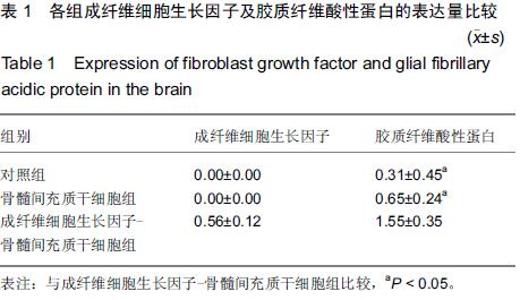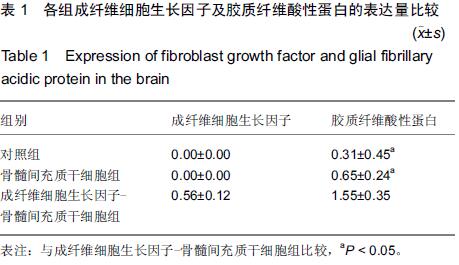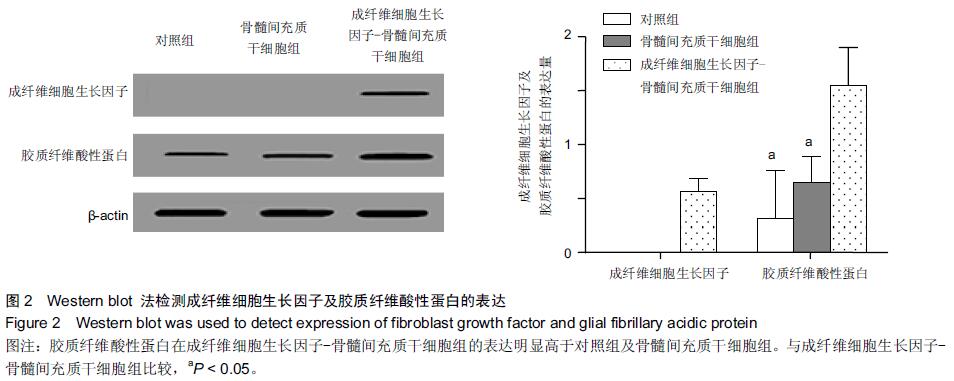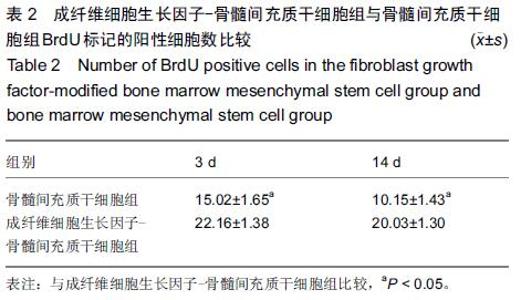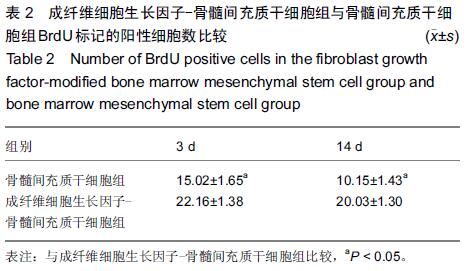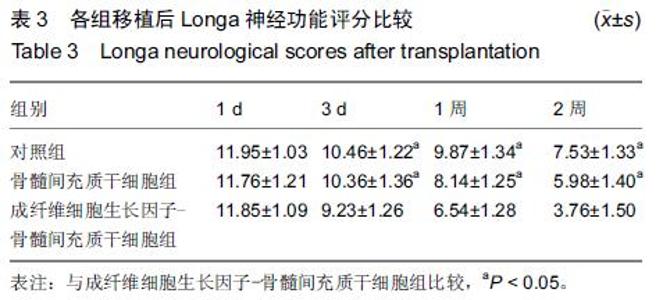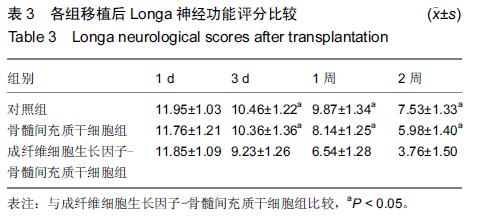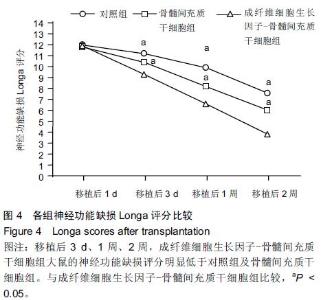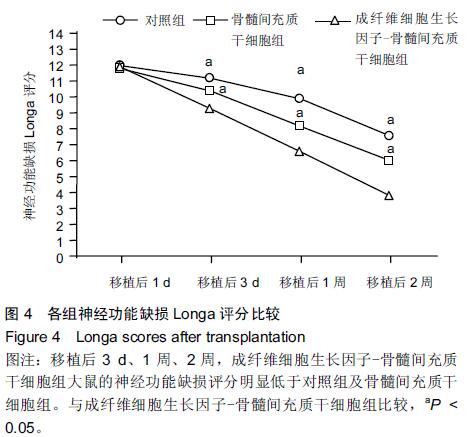Chinese Journal of Tissue Engineering Research ›› 2015, Vol. 19 ›› Issue (45): 7279-7285.doi: 10.3969/j.issn.2095-4344.2015.45.012
Previous Articles Next Articles
Fibroblast growth factor-modified bone marrow mesenchymal stem cells promote functional recovery from traumatic brain injury
Li Xue-dong, Chen Jia-kang, Qin Jun, Mai Yong-jun, Xiao Zhen-yong
- Liuzhou Workers Hospital, Liuzhou 545000, Guangxi Zhuang Autonomous Region, China
-
Received:2015-09-19Online:2015-11-05Published:2015-11-05 -
Contact:Chen Jia-kang, Chief physician, Liuzhou Workers Hospital, Liuzhou 545000, Guangxi Zhuang Autonomous Region, China -
About author:Li Xue-dong, Associate chief physician, Liuzhou Workers Hospital, Liuzhou 545000, Guangxi Zhuang Autonomous Region, China
Cite this article
Li Xue-dong, Chen Jia-kang, Qin Jun, Mai Yong-jun, Xiao Zhen-yong. Fibroblast growth factor-modified bone marrow mesenchymal stem cells promote functional recovery from traumatic brain injury[J]. Chinese Journal of Tissue Engineering Research, 2015, 19(45): 7279-7285.
share this article
|
[1] Liu X, Zhou C, Li Y, et al. SDF-1 promotes endochondral bone repair during fracture healing at the traumatic brain injury condition. PLoS One. 2013;8(1):54077.
[2] 马宁,蔡继福,姜卫剑,等.局灶性脑缺血动物模型的制备[J].神经损伤与功能重建,2010,5(1): 53-55.
[3] 姜义娜,田福荣,林倩,等.bFGF 经鼻给药对大鼠缺血再灌注脑损伤的保护作用[J].温州医科大学学报,2015,45(8):560-565.
[4] 先德海,余崇林.骨髓间充质干细胞治疗创伤性脑损伤的研究进展[J].泸州医学院学报,2015,35(3):337-339.
[5] Noda M,Takii K,Parajuli B,et al.FGF-2 released from degenerating neurons exerts microglial-induced neuroprotection via FGFR3-ERK signaling pathway. J Neuroinflammation. 2014;11(76): 1176-1186.
[6] 杨国强,范学慧,萧洪文,等.骨髓间充质干细胞移植治疗缺血性脑损伤的最新研究进展[J].四川解剖学杂志,2013,21(3):32-35.
[7] Zechel S,Werner S,Unsicker K,et al.Expression and functions of fibroblast growth factor 2(FGF-2) in hippocampal formation. Neuroscientist. 2010;16(4):357-373.
[8] 程发峰,宋少婷,郭少英,等.神经功能损伤评分在大鼠脑缺血实验中的应用[J].中国比较医学杂志,2011,21(3):43-48.
[9] 邢雪松,吕威力,赵海,等.bFGF对局灶性脑缺血大鼠脑组织GRP78表达的影响[J].解剖学研究,2012,34(4):290-292.
[10] 郭继东,王月,信宏,等.骨髓间充质干细胞移植对缺血性脑卒中大鼠的细胞外信号调节蛋白激酶的影响[J].中风与神经疾病杂志, 2010,27(12):1124-1125.
[11] Hou Y, Ryu CH, Jun JA,et al.IL-8 enhances the angiogenic potential of human bone marrow mesenchymal stem cells by increasing vascular endothelial growth factor.Cell Biol Int. 2014;38(9):1050-1059.
[12] 董平,焦虎,李秋晨,等.人骨髓间充质干细胞体外成骨与成脂分化过程中FGF1及其受体表达的变化[J].基础医学与临床,2013, 33(8):941-946.
[13] 郭伟韬,王辉,刘思景,等.人骨形态发生蛋白2和人成纤维细胞生长因子2双基因共表达腺病毒载体转染人骨髓基质干细胞后的细胞增殖[J].中国组织工程研究,2012,16(23):4273-4278.
[14] 闫晓鹏,刘跃亭,段虎,等.大鼠液压冲击颅脑损伤后核因子,kB在脑组织的表达变化的研究[J].中西医结合心脑血管病杂志, 2008, 6(6):685-687.
[15] 朱欢,蒋犁,乔立兴,等.碱性成纤维细胞生长因子在新生大鼠缺氧缺血性脑损伤后海马神经发生中的作用[J].江苏医药,2011, 37(21):2502-2504.
[16] Geng CK, Cao HH, Ying X,et al.Effect of mesenchymal stem cells transplantation combining with hyperbaric oxygen therapy on rehabilitation of rat spinal cord injury.Asian Pac J Trop Med. 2015;8(6):468-473.
[17] 于奎营,韩江全,张海霞,等.bFGF对大鼠脑缺血再灌注侧皮质区细胞凋亡及p-Akt(Ser473)表达的影响[J].广东医学,2010, 31(23): 3035-3037.
[18] Yin F, Guo L, Meng CY, et al. Transplantation of mesenchymal stem cells exerts anti-apoptotic effects in adult rats after spinal cord ischemia-reperfusion injury. Brain Res. 2014;1561: 1-10.
[19] 李玉美,余德立,刘来兵,等.碱性成纤维细胞生长因子预诱导后加入丹参酮ⅡA体外定向培养骨髓间充质干细胞向神经元样细胞的分化[J].中国组织工程研究,2012,16(10):1884-1888.
[20] 于晓云,张博爱,李俊敏,等.骨髓间充质干细胞移植对慢性脑缺血大鼠海马区Cdc42表达及认知功能的影响[J].中国老年学杂志, 2013,33(4):829-831.
[21] 陈茉弦,敖丽娟,李琦,等.脑卒中动物模型的建立与比较[J].中国康复医学杂志,2011,26(8): 779-782.
[22] 周媛莉,苏浩彬.间充质干细胞移植对缺氧缺血性脑损伤新生大鼠脑内碱性成纤维细胞生长因子含量的影响[J].中国新生儿科杂志,2010,25(4):226-229.
[23] Charbord P, Livne E, Gross G, et al.Human bone marrow mesenchymal stem cells:a systematic reappraisal via the genostem experience.Stem Cell Rev. 2011;7(1):32-42.
[24] 贾美娟,梁新华.大鼠脑挫伤后碱性成纤维细胞生长因子的表达变化与损伤时间的推断研究[J].中国医药导报,2012,9(23): 16-18.
[25] 曹文锋,王卫真,高幼奇,等.立体定向移植骨髓间充质干细胞对脑缺血再灌注模型大鼠的治疗作用[J].中国神经精神疾病杂志, 2011,37(7):385-389.
[26] Enevoldsen MN,Kochoyan A,Jurgenson M,et al. Neuroprotective and memory enhancing properties of a dual agonist of the FGF receptor and NCAM. Neurobiol Dis. 2012; 48(3): 533-545.
[27] 王增荣,张永红,李二峰,等.载碱性成纤维细胞生长因子纳米缓释系统与骨髓间充质干细胞的增殖[J].中国组织工程研究,2012, 16(47):8794-8797.
[28] Yin F,Meng C,Lu R,et al.Bone marrow mesenchymal stem cells repair spinal cord ischemia/reperfusion injury by promoting axonal growth and anti-autophagy. Neural Regen Res. 2014;9(18):1665-1671.
[29] 蔡弢艺,陈雄生,贾连顺,等.碱性成纤维细胞生长因子重组腺病毒转染兔骨髓间充质干细胞的表型变化[J].中国组织工程研究, 2012,18(23):3727-3731.
[30] 王孝安,刘卫平,刘阳,等.脑室内注射碱性成纤维细胞生长因子治疗大鼠创伤陛脑外伤的实验研究[J].中华神经医学杂志,2010, 9(1):24-28.
[31] 王宁,杨树源,赵均铭.大鼠骨髓间充质干细胞静脉移植治疗大鼠脑损伤[J].中华神经医学杂志,2010,11(6):1097-1099.
[32] Kawabori M,Kuroda S,Ito M,et al.Timing and cell dose determine therapeutic effects of bone marrow stromal cell transplantation in rat model ofcerebral infarct. Neuropathology. 2013;33(2):140-148.
[33] Zhang Y, Zheng J, Zhou Z, et al. Fractalkine promotes chemotaxis of bone marrow-derived mesenchymal stem cells towards ischemic brain lesions through Jak2 signaling and cytoskeletal reorganization. FEBS J. 2015;282(5):891-903.
[34] Quittet MS, Touzani O, Sindji L, et al. Effects of mesenchymal stem cell therapy, in association with pharmacologically active microcarriers releasing VEGF, in an ischaemic stroke model in the rat. Acta Biomater. 2015;15:77-88.
[35] Yang C, Liu H, Liu D. Mutant hypoxia-inducible factor 1α modified bone marrow mesenchymal stem cells ameliorate cerebral ischemia. Int J Mol Med. 2014;34(6):1622-1628.
[36] Li N, Wang P, Ma XL, et al. Effect of bone marrow stromal cell transplantation on neurologic function and expression of VEGF in rats with focal cerebral ischemia. Mol Med Rep. 2014;10(5):2299-2305.
[37] Karlupia N, Manley NC, Prasad K, et al. Intraarterial transplantation of human umbilical cord blood mononuclear cells is more efficacious and safer compared with umbilical cord mesenchymal stromal cells in a rodent stroke model. Stem Cell Res Ther. 2014;5(2):45.
[38] Jeong CH, Kim SM, Lim JY, et al. Mesenchymal stem cells expressing brain-derived neurotrophic factor enhance endogenous neurogenesis in an ischemic stroke model. Biomed Res Int. 2014;2014:129145.
[39] Zhao Y, Lai W, Xu Y, et al. Exogenous and endogenous therapeutic effects of combination Sodium Ferulate and bone marrow stromal cells (BMSCs) treatment enhance neurogenesis after rat focal cerebral ischemia. Metab Brain Dis. 2013;28(4):655-666.
[40] Suzuki J, Sasaki M, Harada K, et al. Bilateral cortical hyperactivity detected by fMRI associates with improved motor function following intravenous infusion of mesenchymal stem cells in a rat stroke model. Brain Res. 2013;1497:15-22.
|
| [1] | Pu Rui, Chen Ziyang, Yuan Lingyan. Characteristics and effects of exosomes from different cell sources in cardioprotection [J]. Chinese Journal of Tissue Engineering Research, 2021, 25(在线): 1-. |
| [2] | Lin Qingfan, Xie Yixin, Chen Wanqing, Ye Zhenzhong, Chen Youfang. Human placenta-derived mesenchymal stem cell conditioned medium can upregulate BeWo cell viability and zonula occludens expression under hypoxia [J]. Chinese Journal of Tissue Engineering Research, 2021, 25(在线): 4970-4975. |
| [3] | Zhang Tongtong, Wang Zhonghua, Wen Jie, Song Yuxin, Liu Lin. Application of three-dimensional printing model in surgical resection and reconstruction of cervical tumor [J]. Chinese Journal of Tissue Engineering Research, 2021, 25(9): 1335-1339. |
| [4] | Hou Jingying, Yu Menglei, Guo Tianzhu, Long Huibao, Wu Hao. Hypoxia preconditioning promotes bone marrow mesenchymal stem cells survival and vascularization through the activation of HIF-1α/MALAT1/VEGFA pathway [J]. Chinese Journal of Tissue Engineering Research, 2021, 25(7): 985-990. |
| [5] | Shi Yangyang, Qin Yingfei, Wu Fuling, He Xiao, Zhang Xuejing. Pretreatment of placental mesenchymal stem cells to prevent bronchiolitis in mice [J]. Chinese Journal of Tissue Engineering Research, 2021, 25(7): 991-995. |
| [6] | Liang Xueqi, Guo Lijiao, Chen Hejie, Wu Jie, Sun Yaqi, Xing Zhikun, Zou Hailiang, Chen Xueling, Wu Xiangwei. Alveolar echinococcosis protoscolices inhibits the differentiation of bone marrow mesenchymal stem cells into fibroblasts [J]. Chinese Journal of Tissue Engineering Research, 2021, 25(7): 996-1001. |
| [7] | Fan Quanbao, Luo Huina, Wang Bingyun, Chen Shengfeng, Cui Lianxu, Jiang Wenkang, Zhao Mingming, Wang Jingjing, Luo Dongzhang, Chen Zhisheng, Bai Yinshan, Liu Canying, Zhang Hui. Biological characteristics of canine adipose-derived mesenchymal stem cells cultured in hypoxia [J]. Chinese Journal of Tissue Engineering Research, 2021, 25(7): 1002-1007. |
| [8] | Geng Yao, Yin Zhiliang, Li Xingping, Xiao Dongqin, Hou Weiguang. Role of hsa-miRNA-223-3p in regulating osteogenic differentiation of human bone marrow mesenchymal stem cells [J]. Chinese Journal of Tissue Engineering Research, 2021, 25(7): 1008-1013. |
| [9] | Lun Zhigang, Jin Jing, Wang Tianyan, Li Aimin. Effect of peroxiredoxin 6 on proliferation and differentiation of bone marrow mesenchymal stem cells into neural lineage in vitro [J]. Chinese Journal of Tissue Engineering Research, 2021, 25(7): 1014-1018. |
| [10] | Zhu Xuefen, Huang Cheng, Ding Jian, Dai Yongping, Liu Yuanbing, Le Lixiang, Wang Liangliang, Yang Jiandong. Mechanism of bone marrow mesenchymal stem cells differentiation into functional neurons induced by glial cell line derived neurotrophic factor [J]. Chinese Journal of Tissue Engineering Research, 2021, 25(7): 1019-1025. |
| [11] | Duan Liyun, Cao Xiaocang. Human placenta mesenchymal stem cells-derived extracellular vesicles regulate collagen deposition in intestinal mucosa of mice with colitis [J]. Chinese Journal of Tissue Engineering Research, 2021, 25(7): 1026-1031. |
| [12] | Pei Lili, Sun Guicai, Wang Di. Salvianolic acid B inhibits oxidative damage of bone marrow mesenchymal stem cells and promotes differentiation into cardiomyocytes [J]. Chinese Journal of Tissue Engineering Research, 2021, 25(7): 1032-1036. |
| [13] | Wang Xianyao, Guan Yalin, Liu Zhongshan. Strategies for improving the therapeutic efficacy of mesenchymal stem cells in the treatment of nonhealing wounds [J]. Chinese Journal of Tissue Engineering Research, 2021, 25(7): 1081-1087. |
| [14] | Wang Shiqi, Zhang Jinsheng. Effects of Chinese medicine on proliferation, differentiation and aging of bone marrow mesenchymal stem cells regulating ischemia-hypoxia microenvironment [J]. Chinese Journal of Tissue Engineering Research, 2021, 25(7): 1129-1134. |
| [15] | Zeng Yanhua, Hao Yanlei. In vitro culture and purification of Schwann cells: a systematic review [J]. Chinese Journal of Tissue Engineering Research, 2021, 25(7): 1135-1141. |
| Viewed | ||||||
|
Full text |
|
|||||
|
Abstract |
|
|||||


